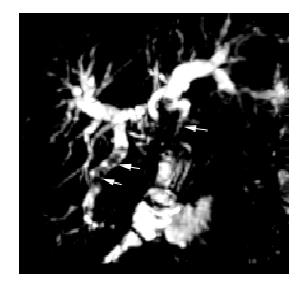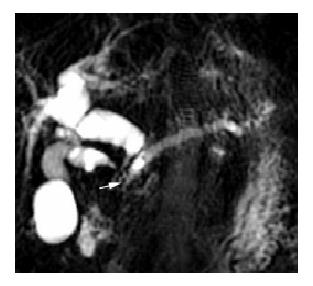Copyright
©The Author(s) 2004.
World J Gastroenterol. Oct 15, 2004; 10(20): 3034-3038
Published online Oct 15, 2004. doi: 10.3748/wjg.v10.i20.3034
Published online Oct 15, 2004. doi: 10.3748/wjg.v10.i20.3034
Figure 1 MRCP of a 78-year-old female patient.
The common bile duct is dilated with a stricture at the level of the papilla of Vateri (open arrow), with multiple stones in the gallbladder (solid arrow). The Wirsung duct is not visible.
Figure 2 MRCP of a 58-year-old female patient in whom ERCP failed because of a previous Billroth II resection.
The intrahepatic biliary tree is markedly dilated with stones (open arrows), and the choledochojejunostomy anastomosis is nar-rowed (solid arrow). The patient underwent hepaticotomy and Kehr drainage.
Figure 3 MRCP of a 63-year-old male patient in whom ERCP failed because of duodenal stenosis.
The calcified pancreatic head obstructs the Wirsung duct and the common bile duct (arrow) with an upstream dilation, causing the “double duct sign”. The intrahepatic biliary tree and the cystic duct are also dilated. The patient underwent choledochojejunostomy, gas-trojejunostomy and Wirsungogastrostomy.
Figure 4 Normal Wirsung duct and bilateral renal cysts in an 81-year-old female patient.
The intraluminal focus with low signal intensity in the distal common bile duct (arrow) proved to be cholangiocarcinoma. The biliary tree is dilated. With regard to her age and physical status, the patient underwent biliary stent implantation to ensure bile flow.
- Citation: Czakó L, Takács T, Morvay Z, Csernay L, Lonovics J. Diagnostic role of secretin-enhanced MRCP in patients with unsuccessful ERCP. World J Gastroenterol 2004; 10(20): 3034-3038
- URL: https://www.wjgnet.com/1007-9327/full/v10/i20/3034.htm
- DOI: https://dx.doi.org/10.3748/wjg.v10.i20.3034












